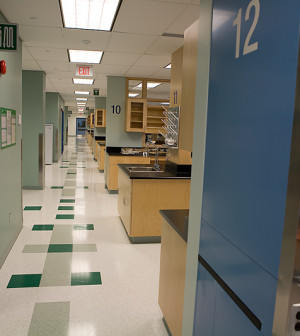- Skip Storing This Everyday Product in the Fridge Door
- Green Tea + B3 Pairing May Boost Brain Health
- Navigating Your Midlife Crisis: Embracing New Possibilities
- City Raccoons Showing Signs of Domestication
- Mapping the Exposome: Science Broadens Focus to Environmental Disease Triggers
- One Week Less on Social Media Linked to Better Mental Health
- Your Brain Changes in Stages as You Age, Study Finds
- Some Suicide Victims Show No Typical Warning Signs, Study Finds
- ByHeart Formula Faces Lawsuits After Babies Sickened With Botulism
- Switch to Vegan Diet Could Cut Your Greenhouse Gas Emissions in Half
Are Routine Ultrasounds for Women With Dense Breasts Worthwhile?


New research questions the value of ultrasound screening for women with dense breasts who’ve had a normal mammogram.
Although dense breasts are a known risk factor for breast cancer, this increasingly common strategy doesn’t appear to improve survival much but does “substantially” boost costs and false-positive results, researchers found.
“Performing ultrasound for all women with dense breasts after a negative mammogram would produce relatively few benefits,” said study researcher Brian Sprague, assistant professor of surgery at the University of Vermont.
In the United States, at least 19 states require doctors to notify women of their breast density after undergoing a mammogram, according to background information in the study. Those with dense breasts may then be advised to talk to their doctor about supplemental testing.
Legislation mandating such notification nationwide is also under consideration, the study says.
“Be aware that screening ultrasound may lead to unnecessary biopsies,” Sprague said. “There is a small chance it could save your life, but there is a much greater chance you will have a false-positive result.”
Breast density is categorized on a scale of 1 to 4, with 1 deemed mostly fatty breasts and 4 being the least fatty and most dense breasts. About 45 percent of women aged 40 to 74 have dense breasts, Sprague found in previous research.
Dense breasts have more fibrous and glandular tissue than fatty tissue, which can also make it difficult for a radiologist to detect cancer on a mammogram. Dense tissue, like cancer, shows up white on the mammogram. Fatty tissue is dark, so any cancer is more visible.
For the study, published in the Dec. 9 online issue of the Annals of Internal Medicine, Sprague and his team used a computer-based simulation model to look at three scenarios. In one, women got routine mammograms only. In the second, women with category 4 breast density got a mammogram and an ultrasound. In the third scenario, Sprague grouped categories 3 and 4 together.
Using information from breast cancer surveillance databases, the researchers looked at how many breast cancer deaths could likely be prevented by adding ultrasound and how many biopsies would occur after a false-positive ultrasound. They also evaluated potential costs.
“The number of deaths prevented is relatively low compared to the false- positive results,” Sprague said.
Performing supplemental ultrasound after normal mammograms on 10,000 women with dense breasts, ages 50 to 74, every year would prevent about four breast cancer deaths, he said.
“At the same time, 3,500 of those women would have had to have a biopsy,” he said, with no cancer detected.
Sprague’s team then calculated how many years of good quality life the extra testing would yield. For each woman, it came down to about 10 hours, he said.
When women with densities of 3 and 4 were considered together, the cost-effectiveness ratio was $325,000 for each year of healthy life gained. “Generally in the United States, people think about $100,000 for a year of quality life gained a good standard,” Sprague said.
One specialist said the study, while interesting, has some inherent limitations. The computer simulation model the researchers used is known to produce credible results, and supplemental ultrasound can improve detection, said Dr. Courtney Vito, assistant clinical professor of surgical oncology at City of Hope Cancer Center in Duarte, Calif. But doctors haven’t done it long enough to determine if it actually makes a survival difference in women, she said.
“Breast cancer tends to grow rather slowly in most cases,” said Vito, who wasn’t involved in the study.
Sprague and Vito agreed that a more advanced form of screening, digital tomosynthesis, may prove to be a better supplemental test for women at higher risk of breast cancer. This relatively new 3-D picture technique is not yet widely available.
In the meantime, Vito said, women who learn they have dense breasts can discuss with their doctors the pros and cons of supplemental testing.
More information
For more about risk factors for breast cancer, see American Cancer Society.
Source: HealthDay
Copyright © 2025 HealthDay. All rights reserved.










